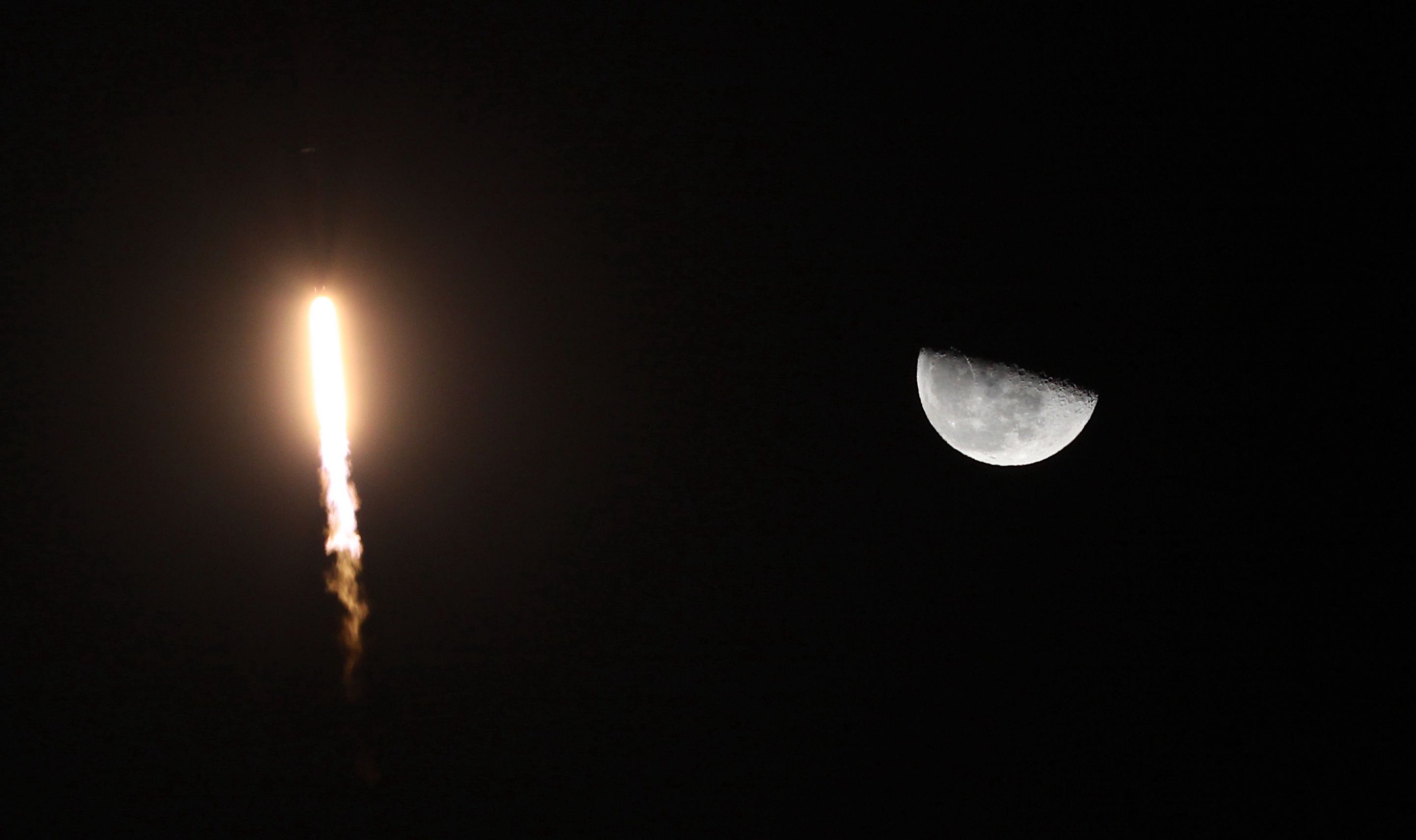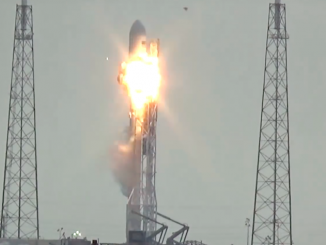
Sixty more SpaceX-owned Starlink internet satellites rocketed through a moonlit winter sky over Cape Canaveral aboard a Falcon 9 launcher early Thursday, while another Falcon 9 stood on a different launch pad a few miles away to loft another 60 Starlink payloads Friday.
Nine Merlin 1D engines flashed to life and sent a rumble across Florida’s Space Coast at 1:19 a.m. EST (0619 GMT) Thursday. Hold-down clamps released to allow the 229-foot-tall (70-meter) Falcon 9 rocket to climb off pad 40 at Cape Canaveral Space Force Station.
The Falcon 9’s guidance system steered the rocket northeast from Cape Canaveral to align with planned orbital inclination of the Starlink satellites.
After surpassing the speed of sound, the Falcon 9 soared into the rarefied uppermost layers of the atmosphere and shed its 15-story first stage booster around two-and-a-half minutes into the flight. An upper stage engine ignited to continue accelerating into orbit with the 60 Starlink satellites, while the first stage — designed B1060 in SpaceX’s reusable rocket inventory — descended to an on-target landing on SpaceX’s drone ship “Of Course I Still Love You” nearly 400 miles (630 kilometers) downrange in the Atlantic Ocean.
The first stage’s landing punctuated the fifth trip to space and back for this booster, and it broke a record for the fastest turnaround between flights of a SpaceX booster, besting the previous mark of 38 days set last month.
Here’s a replay of the Falcon 9 rocket launching minutes ago from Cape Canaveral Space Force Station.
This was the fourth Falcon 9 launch of the year, and the 107th Falcon 9 flight overall since 2010.https://t.co/TyXGKQ0Tf3 pic.twitter.com/7zhgSix4m9
— Spaceflight Now (@SpaceflightNow) February 4, 2021
The booster on Thursday’s mission last flew Jan. 7 with the Turksat 5A communications satellite, just 27 days ago.
The Falcon 9’s upper stage reached a preliminary orbit with the 60 Starlink satellites about nine minutes after liftoff Tuesday, then reignited its engine for one second to maneuver into a targeted orbit ranging between 155 miles and 180 miles (250-by-291 kilometers) in altitude.
The 60 Starlink satellites deployed from the rocket a little more than an hour after liftoff, while flying over the Pacific Ocean near New Zealand.
With the fresh broadband relay stations launched Thursday, SpaceX’s Starlink fleet appears to have grown to more 1,000 active satellites, according to data gathered by Jonathan McDowell, an astronomer at the Harvard-Smithsonian Center for Astrophysics who tracks global satellite and launch activity.
In total, the company has launched 1,085 satellites to date, including prototypes and failed spacecraft that are no longer in orbit.
Another 60 Starlink satellites are mounted on a Falcon 9 rocket awaiting liftoff from pad 39A, a few miles north of pad 40 at NASA’s Kennedy Space Center. That launch has been grounded several days to await better weather conditions in the offshore booster landing zone in the Atlantic Ocean.
SpaceX briefly planned to launch both Falcon 9 rockets less than five hours apart early Thursday, but the company said Wednesday afternoon that the mission from pad 39A would be pushed back until Friday morning at 5:14 a.m. EST (1014 GMT) “to allow additional time for pre-launch checks.”
Flying 170 miles above Earth near New Zealand, the Falcon 9 rocket’s upper stage just deployed 60 more Starlink internet satellites to join SpaceX’s ever-growing fleet of broadband relay platforms in orbit. https://t.co/TyXGKQ0Tf3 pic.twitter.com/TARFqiuqf6
— Spaceflight Now (@SpaceflightNow) February 4, 2021
SpaceX has both of its ocean-going rocket landing platforms, or drone ships, deployed in the Atlantic Ocean for the two Starlink missions.
The two missions will be the 18th and 19th dedicated Falcon 9 flights for the Starlink network, which SpaceX is building out to provide broadband internet services around the world. Thursday’s mission was SpaceX’s fourth Falcon 9 launch of the year, and the 107th Falcon 9 flight overall since 2010.
SpaceX says the Starlink network is providing preliminary low-latency internet service to users in the United States, Canada, and the United Kingdom through a beta testing program. Commercial service will begin after SpaceX has its initial network of around 1,584 satellites in orbit, including spares.
The quarter-ton Starlink satellites are built by SpaceX technicians and engineers in Redmond, Washington.
The initial block of Starlink satellites, including the 60 launched Thursday, fly in mid-inclination orbits tilted 53 degrees to the equator. The new Starlink satellites will unfurl their solar panels and activate their automated krypton ion thrusters to reach their final operating positions in the network.
Once operational, they will orbit at an altitude of 341 miles, or 550 kilometers, to provide broadband coverage over nearly all of the populated world.
SpaceX plans to launch more Starlink satellites into polar orbit to enable global coverage for maritime and aviation customers, including the U.S. military. The company has regulatory approval to launch around 12,000 Starlink satellites.



